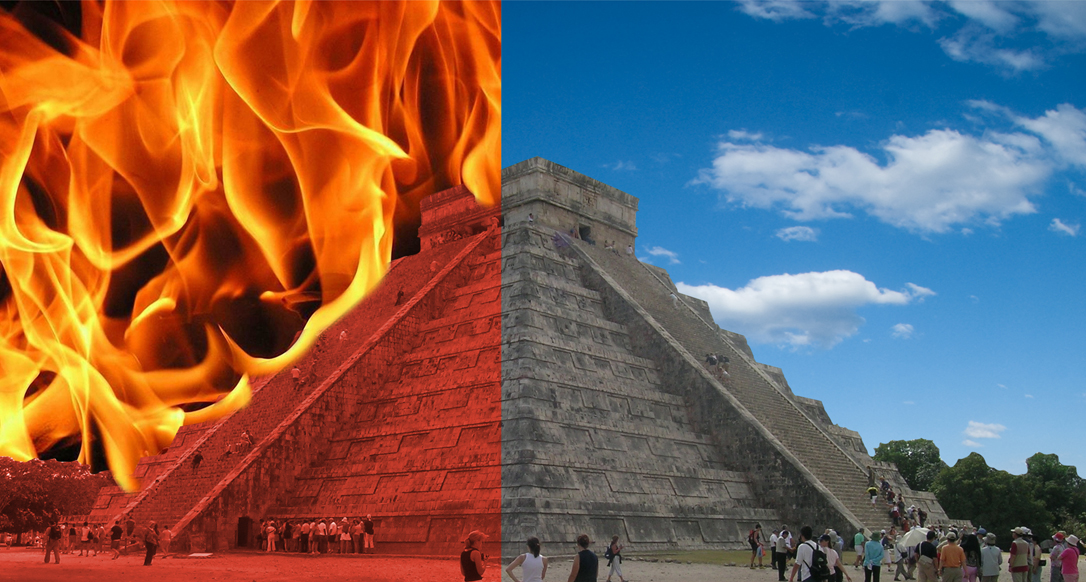Elon faculty members explore facts and fiction of the Maya prophecy regarding the world ending on Dec. 21.
|
|
Polar shifts. Solar storms. Volcanic eruptions.
It seems there is no shortage of interpretations for what may happen on Dec. 21, the date some believe the ancient Maya predicted the world would come to an end.
A Google search on the topic can yield close to 2.8 million results depending on the search terms used. Books attempting to decode the mystery litter bookstores’ shelves.
“The whole concept of 2012 is huge,” says Donna Van Bodegraven, associate professor in the Department of Foreign Languages. “It’s been taken over by New Age writers and popular culture” and blown out of proportion.
As part of an upper-level general studies course she taught last fall, Van Bodegraven and her students looked at original Maya sources and compared them to interpretations presented in feature films, documentaries and books. She invited fellow faculty members to provide different perspectives for the class. One of those was Tony Crider, associate professor of physics, who co-taught a Winter Term course with Van Bodegraven in Mexico. They visited archaeological sites in the Yucatan Peninsula and encouraged their students to make connections between ancient and modern astronomy.
“People want to believe in these things. They want a sense of mystery,” says Crider, a frequent lecturer to local audiences about Maya astronomy as it relates to the 2012 prophecies.
Assistant Professor of Sociology and Anthropology Rissa Trachman, who since 1997 has been conducting field work in Belize, where the Maya were based, agrees. She says people seem to be consumed with the idea of Apocalypse and the end of the world.
Because there is so much information and misinformation about the subject, it’s difficult to know what’s legitimate and what’s not. The Magazine of Elon asked Van Bodegraven and Crider to help us distinguish truth from fiction in the following Q&A.
****
Who are the Maya, and what do we know about them?
The Maya civilization traces its origins to pre-Columbian times. Descendants of this diverse indigenous people still live in parts of southern Mexico and northern Central America. The Spanish Conquistadors burned many Maya artifacts in 1697, but some manuscripts, artwork and monuments survived, giving us a fragmented account of their history, Van Bodegraven says. These include books written in the Yucatec Maya language that chronicle legends, predictions, almanacs and remedies. They also include the Maya codices, a collection of manuscripts written in hieroglyphic script that records astronomical tables, the Maya zodiac and prophecies.
What about the Maya calendar?
Van Bodegraven explains the Maya developed several calendars for different purposes, notably the Haab’, a solar calendar of 365 days that kept track of the seasons; the Tzolk’in, a sacred calendar of 260 days that guides dates of religious and ceremonial events; and the Long Count, a cyclical calendar that counts linear time starting with Aug. 11, 3114 B.C., which scholars consider the Maya creation day.
Where does 2012 fit in?
Van Bodegraven says 2012 appears in the Long Count calendar, but its meaning has been greatly misinterpreted. Dates in this calendar use units such as kin (a day), winal (20 kin), tun (360 kin), k’atun (7,200 kin) and b’aktun (20 k’atun or 144,000 kin). Assuming we have the conversion right, Crider says, 2012 marks the final year of the 13th b’aktun (the current cycle according to the Long Count calendar) but not the end of the calendar itself. At the end of a cycle, Van Bodegraven says, “you simply start counting again.”
What about the specific date – Dec. 21?
While thousands of dates are written on Maya monuments, this particular date has only been found at two archaeological sites, Crider says. An inscription recently discovered at the site of La Corona in Guatemala uses the date to describe political history. Another inscription at the Tortuguero site in Mexico suggests something will occur on Dec. 21, but what that something is can’t be read because of erosion. It does mention the descent of the “nine support gods,” and Crider cites Anthony Aveni, an archeo-astronomy scholar, who says the Maya likely viewed this as Westerners view the arrival of the New Year.
“They would not view it in the way people viewed the year 2000 as the end of the world,” Crider adds.
How did this date become “doomsday” in popular culture?
People with commercial interests such as the late Jose Arguelles, a New Age author and artist who wrote the 1987 book The Mayan Factor: Path Beyond Technology, and director Roland Emmerich, who produced Hollywood blockbusters including “2012,” are the primary culprits. Because these cultural products include certain facts about Maya artifacts in their works, Crider says, many people accept their depictions as truth. Those are just two of many examples of misinformation about ancient artifacts from Mesoamerican civilizations.
Crider also mentions the Stone of the Sun, an Aztec artifact that’s often mistaken for the Long Count calendar. The artifact is covered with carvings depicting the culture’s creation story and the water, wind, storms and earthquakes that ended Aztec cosmology’s four prior universes. Crider says many people incorrectly use this type of imagery to reinforce their apocalyptic views.
“People start making assumptions that the earthquakes of late are related to an ancient prophecy, when in reality, they are following normal patterns,” he says.
So, is the world going to end on Dec. 21?
No (at least not due to the Maya calendar). According to Van Bodegraven and Crider, Dec. 21 will be like any other day. So what does Van Bodegraven recommend you do?
“Buy your Christmas gifts and make your plans for the day after,” she says.



